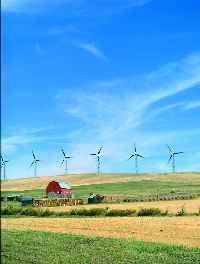| | Wind power | Solar power | Biodiesel
Wind power, solar power and biodiesel are the three most common renewable energy sources for agricultural users at present. Other alternatives such as biogas and earth energy are being developed and may be good options in the future. These options reduce the use of non-renewable energy sources, and so help to reduce harmful emissions.
Wind Power
Modern wind turbines can provide reliable, cost-effective, pollution-free energy for individuals and communities. The cost of these systems depends on the power output. A 1-kW system costs about $5,000, and a large-scale commercial system that produces 600 kW can cost $1 million.

Wind turbines can provide energy for individuals and communities.
Courtesy of ARD
Wind systems need a relatively consistent wind flow. Trees and other obstructions can impede wind flow to the rotors. Collect at least one year of wind data before selecting a site. A wind power system usually requires an average annual wind speed of at least 15 km/h. An average wind speed of greater than 25 km/h is desirable, and over 29 km/h is excellent, especially if the intent is to sell the power.
Solar Power
Capturing enough solar energy for effective use depends on available solar energy, weather conditions, location, the technology used and the application. Although the initial cost of solar energy technology can be high, it has the potential to reduce energy bills considerably and provide an economic source of power in remote areas.
Solar energy can be used to convert sunlight into electrical power.
Courtesy of ARD
On farms, solar energy can be used for heating or to convert sunlight into electricity to power such things as water pumps, electric fencing and grain dryers.
Biodiesel
Biodiesel is made from renewable resources, such as soybean oil, canola oil or animal fats. This high-performing fuel improves air quality by greatly reducing emissions of carbon monoxide, ozone-forming hydrocarbons, hazardous diesel particulates, acid-rain-causing sulphur dioxide, and carbon dioxide. However, nitrogen oxide emissions may increase.
Biodiesel-powered engines deliver similar torque, horsepower, haulage rates and kilometres per litre as petroleum-powered diesels. Biodiesel can be used in existing engines and fuel injection equipment without harming performance. It has superior lubricating properties and can extend engine life. Winter operating procedures are the same for biodiesel as they are for number two petroleum diesel. Biodiesel can be blended with petroleum diesel or used neat (100%). Some farm equipment manufacturers have approved the use of soy-based biodiesel fuel blends for some of their diesel-powered engines.
Biodiesel is currently not available for retail sale, so producers must find their own source. Although it is possible to produce biodiesel on farm, it is not currently an economic option in most situations. Commercial biodiesel is widely available in Europe and may be available in Canada later in this decade.
Back to Chapter 6 - Energy Inputs |
|